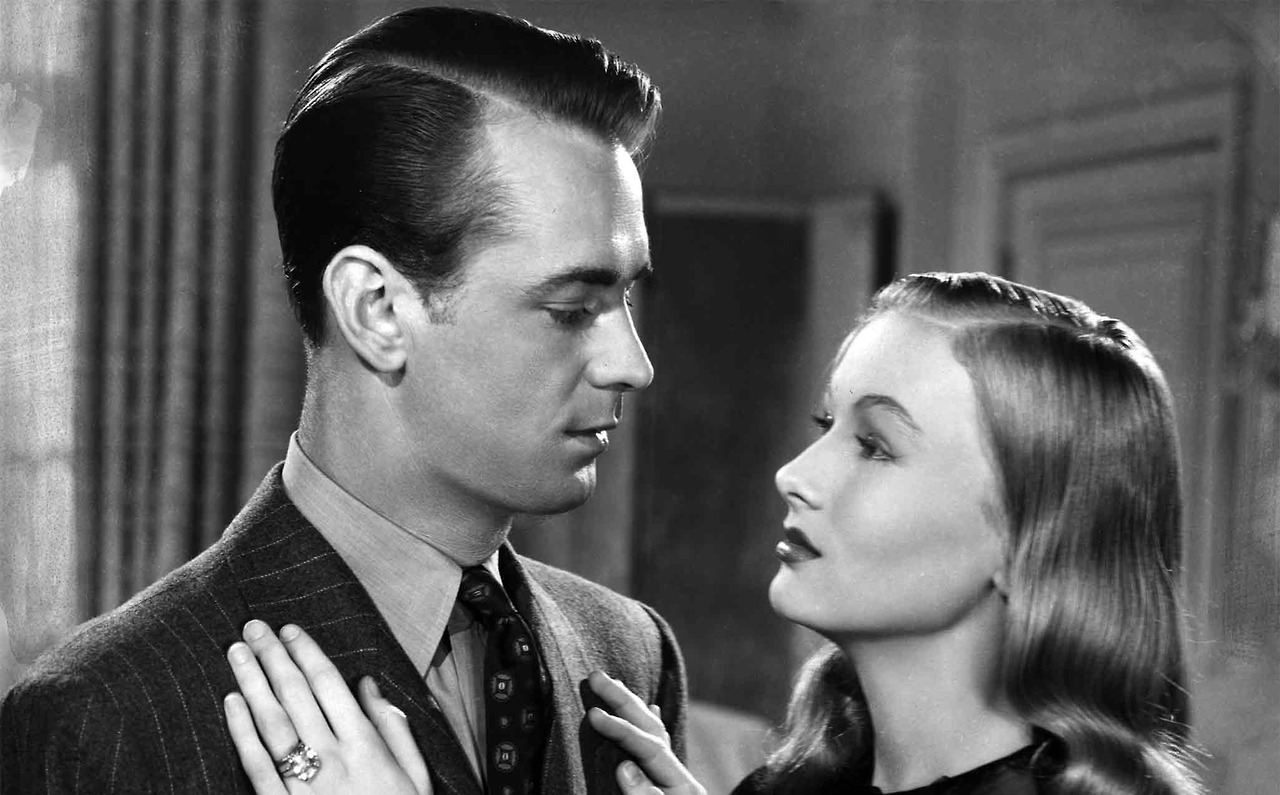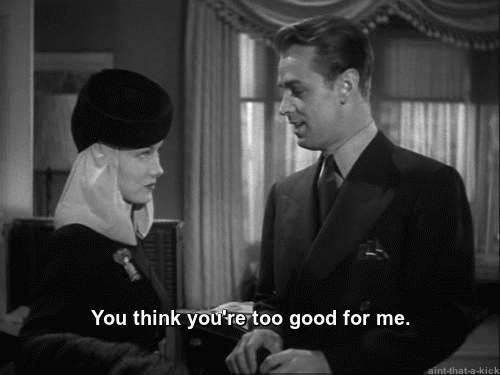Recortes da vida. Quando eu era pequena e via
qualquer filme 'normal' – ou seja, qualquer um que não fosse de animação – eu
ficava fascinada porque compreendia os filmes como sendo recortes da vida.
Aqueles personagens estão ali, em suas próprias histórias, e nós vemos apenas
um pedaço delas. Nós precisamos seguir as pistas e ligar os pontos e descobrir
quais são as ligações e motivações dos personagens. Para mim, era como ser um
detetive em frente a uma tela. Com o tempo eu descobri que nem todos os filmes
são recortes da vida. Mas alguns deles ainda podem ser descritos desta forma,
como “Capitulou Sorrindo”, péssimo título dado no Brasil para “The Glass Key”
(1942).
Slices of life. When I
was little and watched any 'regular' movie – aka not an animated one – I was
fascinated because I understood movies as slices of life. Those characters are
there, in their own story, and you only get a piece of it. You must connect the
clues and the dots and find out the characters' liaisons and motivations. It
was like being a detective in front of the screen. With time I learned that not
all movies are slices of life. But some of them can still be described this way,
like “The Glass Key” (1942).
Todos nós sabemos que há muita coisa em jogo em
uma eleição – e em 1942 isso já era assim. Se tornar governador, fazer
reformas, ser apoiado por um jornal e criticado por outro, até mesmo manipular
a vida familiar e amorosa: tudo isso entra na disputa das eleições. É por isso
que Paul Madvig (Brian Donlevy) e Ralph Henry (Moroni Olsen0) estão ligados de
várias maneiras: eles são aliados nas eleições estaduais. Madvig quer se casar
com a filha de Henry, Janet (Veronica Lake). A irmã de Madvig, Opal (Bonita
Granville), ama o filho de Henry, Taylor (Richard Denning), e quer ajudá-lo a
pagar as dívidas de jogo – algo que o irmão dela não quer. No meio de tudo isso
está Ed Beaumont (Alan Ladd), sócio e melhor amigo de Madvig, e responsável por
resolver todos os problemas.
We all know that there is
a lot involved in an election – and it was the same way in 1942. Becoming
governor, having reforms, being supported by one newspaper and criticized by
the other, even playing with family life and love life: everything enters the
dispute. That's why Paul Madvig (Brian Donlevy) and Ralph Henry (Moroni Olsen)
are connected in more than one way: they are allies in the estate elections.
Madvig wants to marry Henry's daughter, Janet (Veronica Lake). Madvig's sister,
Opal (Bonita Granville), loves Henry's son, Taylor (Richard Denning), and wants
to help him pay his debts – what her brother disapproves. In the middle of all
this there is Ed Beaumont (Alan Ladd), Madvig's parter / best friend and the one
who must solve all troubles.
Ed é um personagem
criado pela mente complexa de Dashiell Hammett, e podemos ver que Ed tem alguns
traços em comum com a mais famosa criação de Hammett: Sam Spade. Tanto Sam
quanto Ed são homens durões vivendo em um mundo cruel, ambos são cínicos, frios
e escondem bem seus sentimentos. Assim, Alan Ladd atua como Humphrey Bogart, o
ator que melhor interpretou Spade, e embora suas expressões sejam estoicas,
podemos ler nos olhos deles os seus sentimentos. Àquela altura, Ladd estava há
quase uma década em Hollywood, como extra, e no ano anterior a “Capitulou
Sorrindo” ele inclusive interpretou um técnico de animação no filme da Disney
“O Dragão Relutante”.
Ed is a character created
by the complicated mind of Dashiell Hammett, and we can see that Ed shares some
traits with Hammett's most famous creation: Sam Spade. Both Sam and Ed are
tough men living in a more-than-tough world, they're cynical, cold and disguise
their feelings well. By doing this, Alan Ladd works a lot like Bogart, the
actor who played Spade the best, and although his expression is kind of stoic,
we can read his feelings in his eyes. By that point, Ladd had been in Hollywood
for nearly a decade, playing extras, and the year before “The Glass Key” he
even appeared as an animator in the Disney movie “The Reluctant Dragon”!
 |
| Alan Ladd, 1941 |
 |
| Alan Ladd, 1942 |
Vamos falar sobre
Veronica Lake: a maravilhosa loira baixinha com o penteado peek-a-boo é
incrível, não? Ela tinha apenas 19 anos quando “Capitulou Sorrindo” foi
filmado, e já mostrava seu talento como atriz. Os momentos em que ela e o
personagem de Ed flertam são muito bem feitos, porque o flerte é muito sutil,
mas a química é evidente. Este é o segundo filme que
eles fizeram juntos.
Let's talk about Veronica
Lake: the wonderful petite blonde with the peek-a-boo hair is amazing, isn't
she? She was only 19 when “The Glass Key” was made, and already showed great
acting skills. The moments in which she and Ladd's character flirt are very
well done, because the flirting was very subtle, but we can see that they have
great chemistry. This is the second film they did together.
“The Glass Key” foi
adaptado pela primeira vez para os cinemas em 1935, com George Raft no papel de
Ed. Como é o caso de
outros trabalhos de Dashiell Hammett, a história era originalmente uma trama
pesada sobre corrupção na política, mas se adaptou perfeitamente à narrativa do
noir. O filme de 1935 não era noir, obviamente, mas a versão de 1942 é
comumente citada em listas de filme noir. Temos nesta versão os ambientes
cheios de sombra, o enquadramento em diagonal dos personagens e, acima de tudo,
Ed como um protagonista moralmente ambíguo. Talvez, como em “À Beira do Abismo”
(1946), “Capitulou Sorrindo” precise ser visto mais de uma vez para ser
completamente apreciado. Afinal, se pudéssemos reviver um ‘recorte da vida’
várias vezes, seríamos capazes de perceber todos os detalhes e ter a
experiência completa para sempre nas nossas mentes.
“The Glass Key” was first adapted into a film in 1935, and George Raft
played the part of Ed. As it was the case with other works by Dashiell Hammett,
the story was a hard-boiled tale of political corruption, but it fits perfectly
the noir narrative. The 1935 movie was not a noir one, of course, but the 1942
version is often cited in noir lists. We have here the shadowy environments,
the diagonal shots and, above all, Ed as a morally ambiguous leading man.
Maybe, like “The Big Sleep” (1946), “The Glass Key” needs more than one viewing
to be fully enjoyed. After all, if we could live a ‘slice of life’ again and
again, we would be able to see all the details and have the whole experience
forever in our minds.
This is my contribution to the Alan Ladd blogathon,
hosted by Hamlette’s Soliloquy.





Thanks for contributing this to the blogathon! You're so right -- this movie is like a little peek into the lives of politicians and the things they might be tempted to do in order to win elections. And into the lives of their friends and family and how they get affected as well.
ReplyDeleteLadd and Lake. They were a hell of a good pair onscreen.
ReplyDeleteOne of my favourite of Hammett's novels and I enjoyed your interesting look at this film version. You made me want to watch it all over again.
ReplyDeleteLove this movie. Ed Beaumont is one of my favorite characters of all-time.
ReplyDeleteI was just thinking that I need to watch this film again. It's been a while and I remember finding it fascinating. I love the baby-faced Ladd as a "morally ambiguous" character.
ReplyDeleteI really do like Hammett's novels and the movies based on them, so I will definitely have to check this movie out! Nice review!!!
ReplyDelete